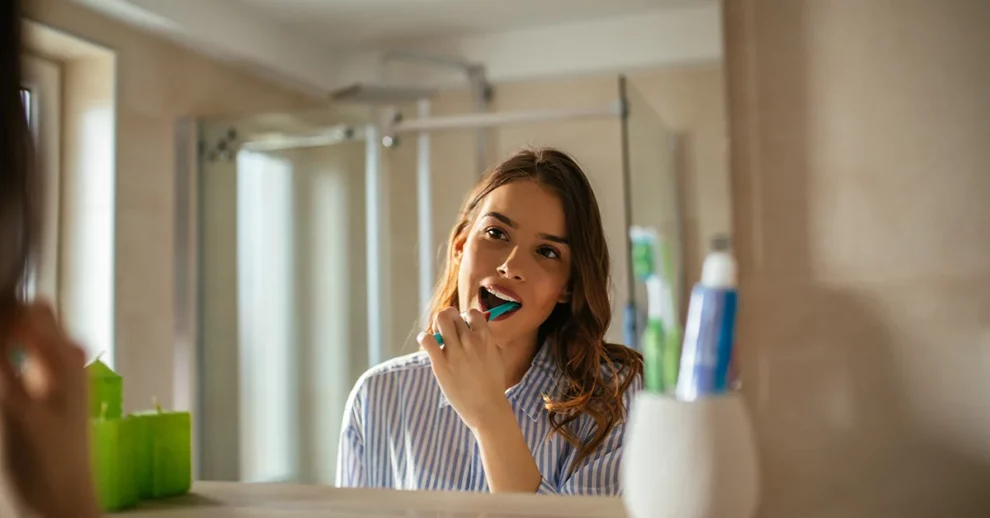Do you wet your toothpaste before brushing? It’s a question that has divided dental experts and people for years. While some people believe that wetting the toothbrush before applying toothpaste is necessary for a good brushing experience, others argue that it’s unnecessary and can even have negative effects on oral health. In this blog post, we’ll explore the pros and cons of wetting your toothbrush before brushing, as well as the alternative of dry brushing, so that you can make decide what works best for you.
Before we dive into the debate about whether to wet or not to wet your toothbrush, let’s first take a brief look at the history of toothpaste and toothbrushes. The use of toothpaste dates back to ancient civilizations, with evidence of toothpowders and pastes being used as early as 5000 BC in Egypt and China.
However, it wasn’t until the late 1800s that modern toothpaste as we know it was developed. Similarly, while early toothbrushes were made from natural materials like animal hair and twigs, the first mass-produced toothbrush was invented in the 1930s. Today, toothpaste and toothbrushes come in a variety of flavors and styles, but the debate over whether to wet or not to wet your toothbrush remains a constant source of discussion.
Table of Contents
The benefits of wetting your toothbrush before brushing
Wetting your toothbrush before brushing has several benefits that can enhance your brushing experience. Here are some of the advantages of wetting your toothbrush before applying toothpaste:
1. Softening the bristles:
Wetting your toothbrush before brushing can help soften the bristles, making them more flexible and gentle on your teeth and gums. This is particularly important if you have sensitive teeth or gums, as using a dry toothbrush can be too abrasive.
2. Spreading the toothpaste evenly:
Wetting your toothbrush before applying toothpaste can help spread the paste more evenly on the bristles, ensuring that every tooth gets covered. This can help improve the effectiveness of the toothpaste, as it can reach all areas of your mouth and clean more thoroughly.
3. Creating a better lather:
Wetting your toothbrush before brushing can help create a better lather, making it easier to spread the toothpaste and clean your teeth. This can help remove more plaque and bacteria from your mouth, improving your overall oral health.
Overall, wetting your toothbrush before brushing can help improve the effectiveness of your brushing routine, making it easier to clean your teeth and maintain good oral hygiene.
The drawbacks of wetting your toothbrush before brushing
While wetting your toothbrush before brushing has its benefits, there are also some potential drawbacks that you should consider. Here are some of the disadvantages of wetting your toothbrush before applying toothpaste:
1. Diluting the toothpaste:
Wetting your toothbrush before applying toothpaste can dilute the paste, reducing its effectiveness. This can be particularly problematic if you’re using fluoride toothpaste, as it can reduce the amount of fluoride that you’re applying to your teeth.
2. Reducing the effectiveness of certain toothpaste:
Some toothpaste, such as whitening toothpaste or those with baking soda, can be less effective when wet. This is because the water can neutralize some of the active ingredients in the toothpaste, reducing their ability to clean and whiten your teeth.
3. Promoting bacterial growth on the toothbrush:
Wetting your toothbrush before brushing can create a moist environment that’s ideal for bacterial growth. This can lead to the accumulation of bacteria on your toothbrush, which can then be transferred to your mouth during brushing.
Overall, while wetting your toothbrush before brushing can have some benefits, it’s also important to be aware of the potential drawbacks. You may want to consider the type of toothpaste you’re using and the overall cleanliness of your toothbrush before deciding whether or not to wet it before brushing.
The alternative of not wetting your toothbrush before brushing
If you’re not a fan of wetting your toothbrush before brushing, there is an alternative: dry brushing. Here are some advantages and disadvantages of dry brushing:
Advantages of dry brushing:
1. More control over the amount of toothpaste:
When you don’t wet your toothbrush before brushing, you have more control over the amount of toothpaste you use. This can be particularly helpful if you’re trying to limit your use of toothpaste or have a small tube that needs to last longer.
2. Avoiding the dilution of toothpaste:
When you don’t wet your toothbrush before brushing, you can prevent diluting the toothpaste and ensure that you get the full benefits of the active ingredients.
Disadvantages of dry brushing:
1. Potentially harsh on teeth and gums:
Dry brushing can be harsh on your teeth and gums, particularly if you’re using a toothbrush with hard bristles. This can lead to enamel erosion and gum recession, making your teeth and gums more sensitive and vulnerable to decay and gum disease.
2. More difficult to spread toothpaste evenly:
Dry brushing can make it more difficult to spread toothpaste evenly on your teeth, which can make it harder to clean every surface thoroughly.
Whether to wet or dry your toothbrush before brushing is a personal preference. If you’re concerned about the potential drawbacks of wetting your toothbrush, dry brushing may be a good alternative. However, it’s important to be aware of the potential risks and disadvantages of dry brushing and make sure that you’re using a toothbrush with soft bristles and brushing gently to avoid damaging your teeth and gums.
Conclusion
Whether to wet your toothbrush before brushing or not is a personal preference. Wetting your toothbrush can help soften the bristles, spread the toothpaste more evenly, and create a better lather, improving the effectiveness of your brushing routine. However, wetting your toothbrush can also dilute the toothpaste and promote bacterial growth on the brush. Dry brushing, on the other hand, can give you more control over the amount of toothpaste and help avoid dilution, but it can be harsh on your teeth and gums and make it more difficult to spread the paste evenly.
Ultimately, the most important thing is to maintain a consistent brushing routine that works for you, whether you wet or dry your toothbrush before brushing. Be sure to choose a toothbrush with soft bristles and brush gently to avoid damaging your teeth and gums. And don’t forget to floss regularly and visit your dentist for check-ups and cleanings to maintain good oral health.




Add Comment